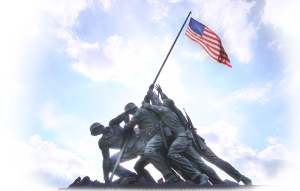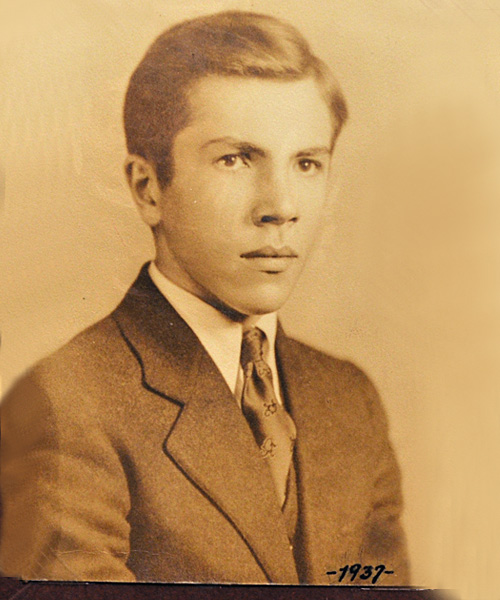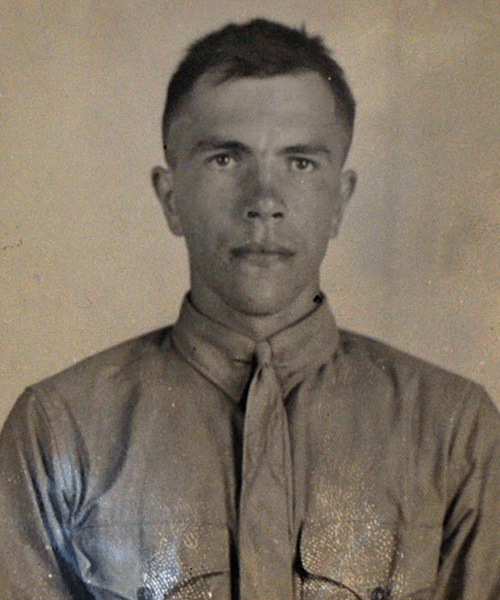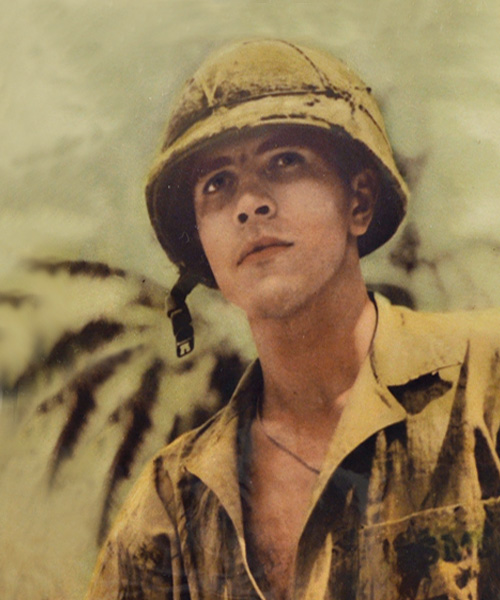
Lesson Plan for Teaching:
A Marine’s Marine, The Story of Sergeant Michael Strank
Subjects: American History (Unit on World War II), Local History (Cambria/Somerset Counties, PA)
Recommended for Grades: 7, 8 and/or 9
Allotted Time: Three class sessions of 40 minutes each, with additional time required for Thank You Sergeant Strank Tribute Project
Lesson Goals and Objectives:
- Students will be able to analyze the importance of the Raising the Flag on Iwo Jima photograph and describe the overarching effects of that famous image.
- Students will be able to identify and describe the series of events that led to the photograph being taken of the flag raising on Iwo Jima.
- Students will be able to identify the overall impact Sgt. Strank had both locally and across the United States.
- Students will analyze why that famous image from 1945 still has such impact today.
- Using Sgt. Strank’s life story for inspiration, students will devise, design, and create a tribute to Sergeant Michael Strank. The students’ completed tributes will be displayed and shared with their local community.
This Lesson Plan aligns with the following Pennsylvania Academic Standards:
CC.8.5: Reading Informational Text
Students read, understand, and respond to informational text – with emphasis on comprehension, making connections among ideas and between texts with focus on textual evidence.
CC.8.5.6-8.A
Cite specific textual evidence to support analysis of primary and secondary sources.
CC.8.5.6-8.B
Determine the central ideas or information of a primary or secondary source; provide an accurate summary of the source distinct from prior knowledge or opinions.
CC.8.6: Writing
Students write for different purposes and audiences. Students write clear and focused text to convey a well-defined perspective and appropriate content.
CC.8.6.6-8.C
Produce clear and coherent writing in which the development, organization, and style are appropriate to task, purpose, and audience.
CC.8.6.6-8.G
Gather relevant information from multiple print and digital sources, using search terms effectively; assess the credibility and accuracy of each source; and quote or paraphrase the data and conclusions of others while avoiding plagiarism and following a standard format for citation.
CC.8.6.6-8.H
Draw evidence from informational texts to support analysis reflection, and research.
8.1: Historical Analysis and Skills Development
8.1.8.A
Compare and contrast events over time and how continuity and change over time influenced those events.
8.2: Pennsylvania History
8.2.8.A
Compare and contrast the social, political, cultural, and economic contributions of specific individuals and groups from Pennsylvania.
8.2.8.D
Compare and contrast examples of how conflict and cooperation among groups and organizations impacted the history and development of Pennsylvania.
• Ethnicity and race
• Immigration
• Military conflict
8.3: United States History
8.3.8.A
Examine the role groups and individuals played in the social, political, cultural, and economic development of the United States.
8.3.8.B
Evaluate the importance of historical documents, artifacts and places critical to United States history.
8.3.8.C
Summarize how continuity and change have impacted U.S. history.
• Technology
8.3.8.D
Examine how conflict and cooperation among groups and organizations have impacted the growth and development of the U.S.
•Military conflict
•Economic Stability
Items Needed for Lesson:
(Suggested Photos, Worksheets and Readings)
Computer and video projector
Videos:
Video documentary: “Our Flag Still Waves”
NBC News 2015 Flashback Interview with Photographer Joe Rosenthal (who died in 2006)
Magazine/Newspaper Articles:
Overview of Iwo Jimo Battle from National Geographic
Smithsonian Connection – Mighty Seventh War Loan Drive
Worksheets to Assist Students in Analyzing Photos:
National Archive Photo Analysis Worksheet
P.O.S.E.R.S. Primary Source Graphic Organizer – PDF
Video response Sheet Graphic Organizer
WSQ (Watch-Summarize-Question) Method
Photographs:
Raising the Flag on Iwo Jima Photograph
Sgt. Michael Strank Gravesite
Slovakia Honors Michael Strank with Stamp Series
Marine Raised Flag at Iwo Jima And Profile of Immigrants’ Service
Iwo Jima Flag Raiser Gets Citizenship Papers
- Marine Corps War Memorial
- The Oath Slovakian Documentary and The Oath Slovakian Documentary 2
- Flags of our Fathers
Background Thoughts:
A Marine’s Marine, The Story of Sergeant Michael Strank
A Marine’s Marine, The Story of Sergeant Michael Strank
Real true heroes are not often found. Men and women of high integrity and incredible honor, whose actions are as awe-inspiring as they are virtuous, seem to be more fable than fact. So when you encounter a person in history, a person who was clearly put on this earth to do good, you naturally want to dig deeper. Michael Strank is that person, that hero. As a beloved son of Cambria County, his story MUST be told for generations to come. As a teacher, you have the opportunity to do this.
It just so happens that Strank’s life story placed him right in the middle of one of the most reproduced images of all time: Raising the Flag on Iwo Jima. When AP Photographer Joe Rosenthal pressed the shutter of his camera on Mount Suribachi, the image of Sgt. Michael Strank and five of his brothers-in-arms swept our nation as a symbol of dedication and perseverance. The photograph was in every newspaper in America, and served as the spark that re-ignited a resolve and deep sense of patriotism that lasted until the end of the war.
Raising the Flag on Iwo Jima was the centerpiece of the Seventh War Loan Drive. This drive raised $26 billion in just six weeks. It was crucial as it was this money that kept the United States focused on winning the war in the Pacific.
Marine Sgt. Michael Strank would have been treated like American royalty if he had left the tiny island of Iwo Jima, but that was not to be. Less than two weeks after the photo was snapped, Sgt. Strank was killed by artillery fire. He died without ever knowing the powerful effect his actions had on millions of Americans, including those in his hometown – Franklin Borough, Johnstown, Pennsylvania.
The goal of this lesson plan is to finish the story of Michael Strank, to demonstrate that he was more than just one sixth of a photograph, more than just a hand steadying a flag pole. He was a devoted son, a caring brother, an inspiring friend, and, most of all, he was a Marine’s Marine.
Suggestions:
How to Use this Lesson Plan
How to Use this Lesson Plan
Ideally, you would be utilizing this lesson plan during the heart of a unit on the Pacific Theatre during World War II. This three day lesson would serve as a nice featurette on the story of the flag raising and the local hero behind it. If this were the case, your students would be aware of the events leading up to the Battle of Iwo Jima and the motives that drove both sides to this tiny island. They also will understand the situation back in the United States, including the general weariness of war and diminishing returns from six previous war bond drives.
Realistically, we understand that many teachers considering this lesson plan are not in the situation described above. Most will treat this as a mini-lesson that can be taught preceding events such as Michael Strank’s birthday, the anniversary of the flag raising on Iwo Jima, Veterans Day and Memorial Day. If this is the case, it is very difficult to assess exactly what knowledge base your students are coming in with. I would suggest surveying your classes, or starting a KWL chart in order to formulate some understanding of their familiarity with the Battle of Iwo Jima and Sgt. Strank. Then using that data, build an introductory lesson or even a quick anticipatory set that can bring your students up to speed. Obviously this doesn’t have to be flashy or even rigorous, but it should be effective enough to cover the following points:
- What was World War II and why were Japan and the United States involved?
- What led these two countries to Iwo Jima? Why was the island a key strategic location? What was at stake for both sides? What was the fighting like between the two countries before Iwo Jima?
- How did people in the United States view the war at this time? What was the war effort like before Iwo Jima?
Day 1
- Start class with an easy-to-setup anticipatory set. On your whiteboard, project an image of Joe Rosenthal’s Raising the Flag on Iwo Jima. Provide no additional information and ask your students to analyze the primary source. You can have them analyze the image using a number of methods:
-
- Photo Analysis Worksheet from the National Archives
- P.O.S.E.R.S. – Primary Source Graphic Organizer
- Class specific primary source analysis method
- Analysis through leading questions and class discussion
-
- Depending on the level of knowledge your students possess, tell the abbreviated story of the Battle of Iwo Jima and the moment that Rosenthal’s photograph was taken. Watch the following NBC News video that looks at Rosenthal’s personal narrative from that day.
-
- Raising The Flag At Iwo Jima: Story Behind The Photo | Flashback | NBC News
-
- Though this is a Michael Strank centric lesson plan, it is crucial to understand just how important Rosenthal’s photograph was to the American public. It reinvigorated our country’s patriotic spirit, brought attention to the seventh war loan drive, and became a symbol of American determination and perseverance. The 1st page of the following Smithsonian Connection article has more information on the Mighty Seventh war loan drive in Pittsburgh. If needed, use this information to bulk up your discussion or even read it in class.
-
- Smithsonian Connection – Mighty Seventh War Loan Drive (1st Page)
-
- Time to transition from the photograph to the man – Sergeant Michael Strank. Depending on your students and school location, Michael Strank may be a household name or it could be the first time they are hearing his name. To start, you can quickly mention Strank’s role in the flag raising and point out where he is located in the photograph. To get a solid understanding of Strank (before you watch Our Flag Still Waves tomorrow); choose to read one of the following three articles. You can use whatever reading strategy works best for your class.
-
- Smithsonian Connection – Mighty Seventh War Loan Drive (2nd Page)
- Nice and simple three paragraph biography, somewhat continues the war loan drive discussion.
- The Uncommon Valor of Michael Strank Biography
- Very detailed when compared to the first option. More appropriate for high school students based on length and language choices.
- The Next Page: Victory at Iwo Jima – Pittsburgh Post-Gazette
- A relatively detailed article as well. When compared to the first two options, this article features more quotes from family members and fellow Marines. Also references some of the memorial projects used to honor Michael Strank, which we will look at in more detail on Day 3.
- Smithsonian Connection – Mighty Seventh War Loan Drive (2nd Page)
-
- To finish up Day 1, you can show an image of Sgt. Michael Strank’s tombstone at Arlington National Cemetery. This should help to drive home Strank’s story and the finality of his tragic death.
- If you so desire, you can pass out an exit slip with a few engaging questions in order to check for understanding.
- Day 2
- Based on data from the exit slip (if you used one), quickly recap the key points or problem areas from yesterday’s lesson.
- Now that we are at the apex of the lesson plan, you will show the documentary on Sgt. Michael Strank entitled Our Flag Still Waves. Your students should have no problem following along, as they now have a nice base of knowledge thanks to yesterday’s lesson. Luckily, there is plenty of new information that will be covered during the 37 minute runtime.
-
- This is an incredible documentary that should keep the attention of your students from start to finish. However, it would be relatively simple to create an activity that will hold students accountable and keep them on task.
- Post an essential question or two on your board to direct learning
- Use a Video response Sheet Graphic Organizer
- Try the WSQ (Watch-Summarize-Question) Method
- This is an incredible documentary that should keep the attention of your students from start to finish. However, it would be relatively simple to create an activity that will hold students accountable and keep them on task.
-
- DAY THree
- If you utilized an activity during yesterday’s documentary, you can start class by reviewing the answers that your students came up with. If not, it shouldn’t be difficult to lead a general recap of the video’s major points through leading questions and class discussion.
- Our last look at Michael Strank will be focused on how he has been remembered (locally, nationally, and internationally) since his heroic actions on Iwo Jima in 1945. Advise your students to pay close attention here, as they will be asked to create a tribute of their own to wrap up this lesson. Divide your students into even groups and give each group a news article that looks at a unique way in which Sgt. Strank has been honored since WW2 came to a close.
-
-
- News articles on Michael Strank can be found under Materials & Resources Section on Day 3.
-
- Have your students read the article as a group and then summarize the major points from the article in paragraph form. The articles are relatively short, so after everyone is finished, the goal will be to share their findings with the class. The method in which you do this is up to you. A few possible strategies include:
-
-
- Have a representative from each group read their summary to the class, fielding and answering questions when needed.
- Use a version of the jigsaw strategy and have a member from each group come together and share their summaries.
-
- When they are finished, use the rest of class time to introduce the Thank You Sergeant Strank – Tribute Project
Evaluation
· While you could easily quiz your students as a way to evaluate what they have learned, that method of assessment does not seem to quite fit with Sgt. Strank and this lesson plan.
· For the last three days, your students have gotten to know and appreciate Sgt. Strank as not only a Marine’s Marine, but as a hometown hero and a truly honorable man. Though his life and legacy have clearly been celebrated and appreciated by many (as evident by Day 3’s lesson), I believe there is always room for additional acts of commemoration.
· The goal of the Thank You Sergeant Strank – Tribute Project is for students to use their newly acquired knowledge to devise, design, and create a tribute to Sergeant Michael Strank. The project itself is really only limited by student imagination, but as the teacher, you can set guidelines and create rubrics as needed.
· Student tribute projects may include, but are NOT limited to:
Thank You Letters
Poems
Posters
Drawings, Sketches, Paintings, and other Artwork
Physical Memorials
Exhibits in a Classroom or a School Display Cases
· Ideally, this project will allow student creativity to flow and stimulate the minds of Cambria County’s youth as they find new ways to honor such an important figure in our nation’s history.





